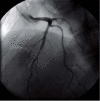Friedreich's ataxia as a cause of premature coronary artery disease
- PMID: 17622372
- PMCID: PMC1894724
Friedreich's ataxia as a cause of premature coronary artery disease
Abstract
Friedreich's ataxia is the most common hereditary neurodegenerative disorder, and more than half of all patients show echocardiographic evidence of cardiomyopathy. Although angina has been reported in these patients, the role of coronary artery disease has previously been dismissed and is therefore underestimated. Premature obstructive coronary disease has rarely been angiographically demonstrated in patients with Friedreich's ataxia. We present an unusual case of a 35-year-old woman with Friedreich's ataxia who presented with intermittent chest pressure associated with dyspnea and diaphoresis. Cardiac catheterization revealed a chronically occluded left circumflex coronary artery and a high-grade stenosis of the left anterior descending coronary artery. A Cypher stent, placed within the left anterior descending artery, left no residual stenosis. This case illustrates the importance of fully investigating anginal symptoms in patients with Friedreich's ataxia, because coronary artery disease is likely underdiagnosed in this population. Early diagnosis may permit aggressive management and may delay the progression to end-stage cardiomyopathy.
Figures



Comment in
-
Mortality in Friedreich's Ataxia.Tex Heart Inst J. 2007;34(4):502-3; author reply 503-4. Tex Heart Inst J. 2007. PMID: 18172544 Free PMC article. No abstract available.
Similar articles
-
Friedreich's ataxia cardiomyopathy: case based discussion and management issues.Ir Med J. 2010 Apr;103(4):117-8. Ir Med J. 2010. PMID: 20486316
-
Myocardial blood flow and oxygen consumption in patients with Friedreich's ataxia prior to the onset of cardiomyopathy.Coron Artery Dis. 2007 Feb;18(1):15-22. doi: 10.1097/01.mca.0000236289.02178.60. Coron Artery Dis. 2007. PMID: 17172925
-
Myocardial ischemia in the absence of epicardial coronary artery disease in Friedreich's ataxia.J Cardiovasc Magn Reson. 2008 Apr 8;10(1):15. doi: 10.1186/1532-429X-10-15. J Cardiovasc Magn Reson. 2008. PMID: 18397518 Free PMC article.
-
[Heart involvement in Friedreich's ataxia].Herz. 2015 Mar;40 Suppl 1:85-90. doi: 10.1007/s00059-014-4097-y. Epub 2014 May 23. Herz. 2015. PMID: 24848865 Review. German.
-
Management and therapy for cardiomyopathy in Friedreich's ataxia.Expert Rev Cardiovasc Ther. 2012 Jun;10(6):767-77. doi: 10.1586/erc.12.57. Expert Rev Cardiovasc Ther. 2012. PMID: 22894632 Review.
Cited by
-
Friedreich's Ataxia: a review from a cardiology perspective.Ir J Med Sci. 2011 Dec;180(4):799-805. doi: 10.1007/s11845-011-0744-y. Epub 2011 Aug 7. Ir J Med Sci. 2011. PMID: 21822977 Review.
-
Mortality in Friedreich's Ataxia.Tex Heart Inst J. 2007;34(4):502-3; author reply 503-4. Tex Heart Inst J. 2007. PMID: 18172544 Free PMC article. No abstract available.
References
-
- Alboliras ET, Shub C, Gomez MR, Edwards WD, Hagler DJ, Reeder GS, et al. Spectrum of cardiac involvement in Friedreich's ataxia: clinical, electrocardiographic and echocardiographic observations. Am J Cardiol 1986;58:518–24. - PubMed
-
- Campuzano V, Montermini L, Molto MD, Pianese L, Cossee M, Cavalcanti F, et al. Friedreich's ataxia: autosomal recessive disease caused by an intronic GAA triplet repeat expansion. Science 1996;271:1423–7. - PubMed
-
- Schols L, Meyer CH, Schmid G, Wilhelms I, Przuntek H. Therapeutic strategies in Friedreich's ataxia. J Neural Transm Suppl 2004;68:135–45. - PubMed
-
- Groh WJ, Zipes DP. Neurological disorders and cardiovascular disease. In: Zipes DP, Libby P, Bonow RO, Braunwald E, editors. Braunwald's heart disease: a textbook of cardiovascular medicine. 7th ed. Philadelphia: Elsevier Saunders; 2005. p. 2153–4.
-
- Labuda M, Labuda D, Miranda C, Poirier J, Soong BW, Barucha NE, Pandolfo M. Unique origin and specific ethnic distribution of the Friedreich ataxia GAA expansion. Neurology 2000;54:2322–4. - PubMed
Publication types
MeSH terms
LinkOut - more resources
Full Text Sources
Medical
